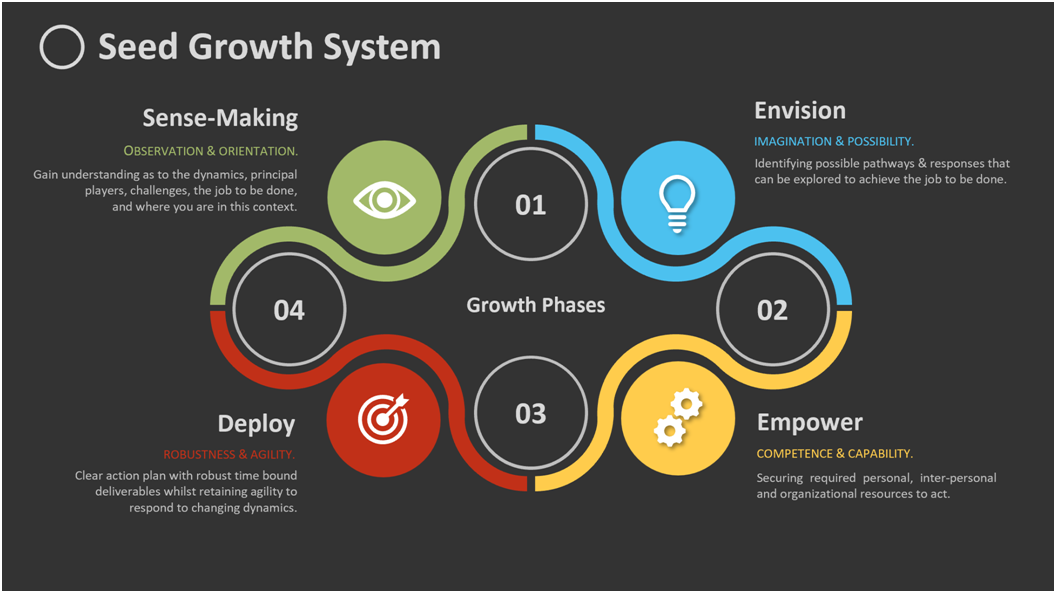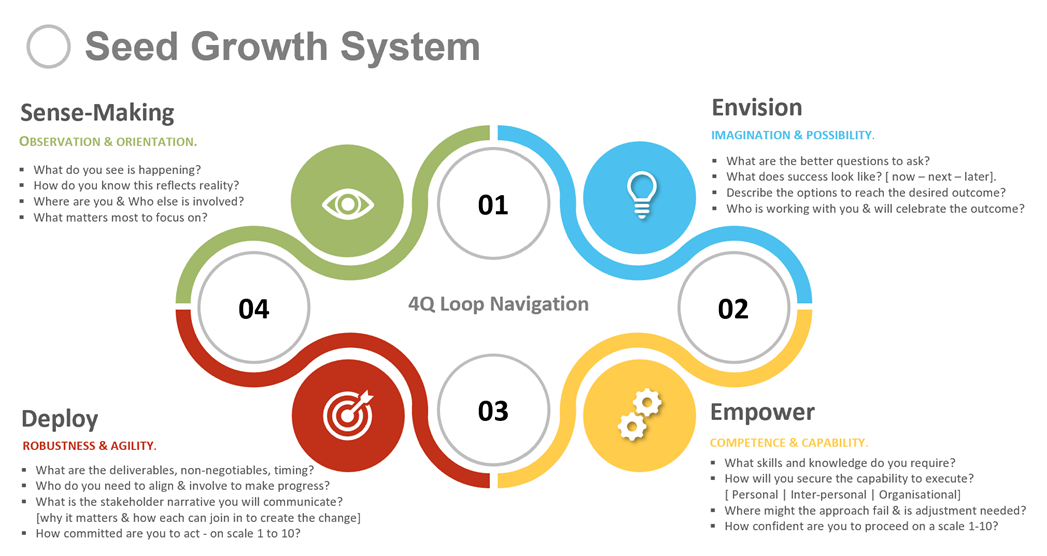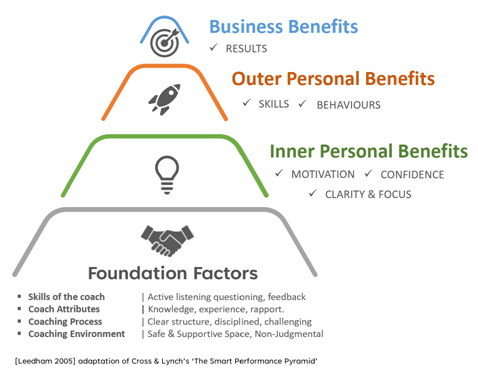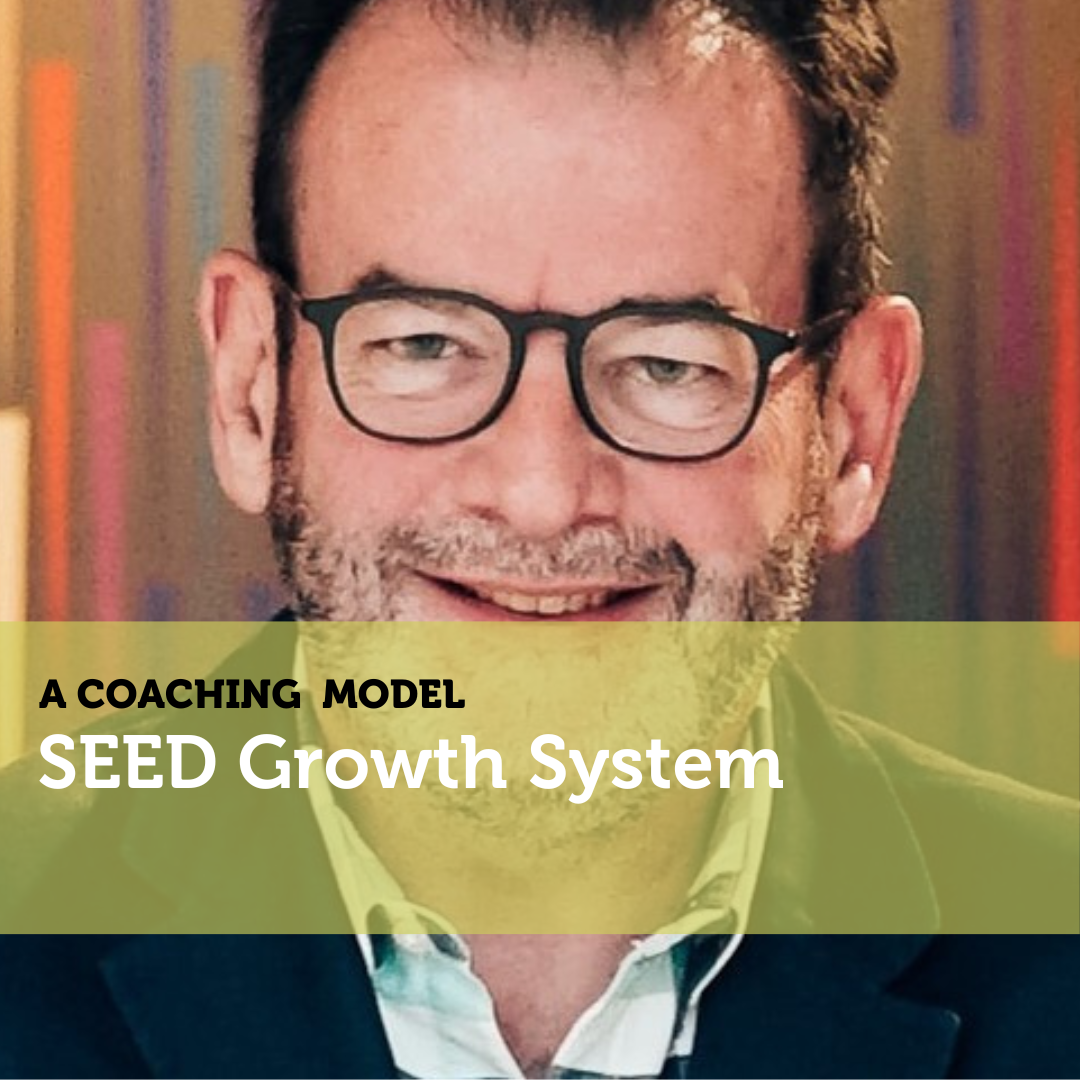A Coaching Model By John Montgomery, Executive & Leadership Coach, AUSTRALIA
SEED Growth System
A systematic model designed to support solution-focused coaching for executives and teams in an organizational setting.
Putting in the Seed

You come to fetch me from my work to-night
When supper’s on the table, and we’ll see
If I can leave off burying the white
Soft petals fallen from the apple tree.
(Soft petals, yes, but not so barren quite,
Mingled with these, smooth bean, and wrinkled pea;)
And go along with you ere you lose sight
Of what you came for and become like me,
Slave to a springtime passion for the earth.
How Love burns through the Putting in the Seed
On through the watching for that early birth
When, just as the soil tarnishes with weed,
The sturdy seedling with arched body comes
Shouldering its way and shedding the earth crumbs.”
Robert Frost 1874 – 1963 1
The SEED Growth System Coaching Model


How Love burns through the Putting in the Seed– Robert Frost1
SEED…a visual metaphor of the creative potential for growth and fruitfulness that resides in people, whether acting individually or as co-collaborators in pursuit of shared value and common good. To unlock this potential energy and support it towards valuable outcomes the ‘SEED Growth System’ is a four-phase coaching modality that combines the practices of observation with orientation, imagination with possibility, competency with capability, and robustness with agility.
It draws on coaching research related to reflective practice, narrative storytelling, positive possibility, and goal achievement through the lens of being solution-focused. It respects the practice of reflection to understand the context and to acknowledge that every individual operates inside a web of relationships both organic and structural.
Context
The model has been created for use as support for executive, leadership, and team coaching.
In particular, Business unit leaders, Function Heads, and Innovation leaders who work in and with diverse teams operating in larger organizational settings.
Foundational Principles
Business coaching is defined as ‘partnering with clients in a thought-provoking and creative process that inspires them to maximize their personal and professional potential’. (SAI- Australian Coaching Standards). Coaching supports the three core stages of leadership development: readiness, willingness, and ability to lead. [MacIntyre 2019]2
The SEED Growth System model provides a flexible approach to support a dynamic partnership between key participants in a coaching engagement (e.g. Coach, Executive[s] and Sponsor) with the purpose of assisting the Executive[s] to navigate the three interwoven spheres of self-management, managing others and the wider impact of decisions at the organizational level.
It utilizes aspects of a systems approach by inviting the coach/ client executive to acknowledge the importance of factors in the wider “ecosystem” the executive is living and operating in. (O’Neill 2000)3 describes this system as ‘the nested set of spheres’ from the personal, through to the macro external environment.
“Coaching is a collaborative solution-focused, result-oriented, systematic process in which the coach facilitates the enhancement of goal attainment, performance, self-directed learning and personal growth of other individuals.” [Grant 2014]4
Sense-Making
People are narrative beings, understanding themselves and the world around them through stories.
Internally our conscious mind narrates in an attempt to create meaning out of experience, whilst the stories we hear and tell each other are central to how we make sense of self in context, and how we make social institutions including the workplace (Vogel M 2012)5.
The model is strengthened by aspects derived from a social constructionist approach. This is evident in providing space and inquiry into understanding the client’s executive[s] story as they see it during the sense-making phase. The coach is encouraged to be ‘be alert to stories, narrative, and metaphor as a gateway to fruitful connection and more effective and deeper interpretation (Robinson 2010)6.
At one level all coaching in the business setting is a narrative process focused on a client executive’s past, present, and emerging stories of change. According to Drake (2007)7 ‘the ultimate goal is to help the person develop a greater sense of agency relative to their narrative patterns and create a broader repertoire so they are able to move more flexibly and adeptly from one position to another as the situation and their goals warrant.’
It is argued that if the coach can assist the executive to become more self-aware of how they ‘selectively frame their experiences’ (Barner and Higgins 2007)8 this can provide insights that can shape both beliefs and subsequent actions that can strengthen their effectiveness inside the organization.
Goal setting is a pivotal decision as it can regulate the direction of action, the knowledge the person searches for the facts they choose to act on, and the intensity of action and perseverance (Latham and Locke 2006)9. To reduce the potential pitfalls of premature goal setting valuing the pre-contemplation and contemplation stages of the change process” (Mukherjee 2008)10 is woven into the sense-making phase.
Envision
Executives come to coaching for many reasons but ‘the bottom line is change’ (Mukherjee 2008)10. For change to occur requires the client to envision future pathways beyond their current reality that are not carbon copies of the past journeys and to intentionally commit to being a catalyst for the desired outcome to emerge. This creative process is pivotal in the envisioning phase and is supported by leveraging practices derived from appreciative inquiry and positive psychology.
The underlying principle is to help the executive foster positive emotions (Higgs 2010)11 that will support a broadening of their thought–action repertoire and build physical, intellectual, and social resources (Frederickson 2001)12. As Watkins and Mohr (2001)13 state ‘appreciative inquiry focuses on the generative and creative images that can be held up, valued, and used as a basis to move forward.
The power to re-frame in times of transition is supported by embarking with better questions.
As Gregerson (2018)14 observes,” Questions rather than answers make it easier to push past cognitive biases and venture into uncharted territory. Lingering in a questioning mode doesn’t come naturally to most people, because we’re conditioned from an early age to keep the answers coming.”
Empower
The model emphasizes the resourcefulness and strengths of the executive to achieve change to secure a desired outcome. The role of the coach is kin to a partner assisting the executive to act intentionally by helping them gather resources that will help and affirm the strengths they see. The challenge for the coach is to remain non-directive in order to safeguard the dialogue space for executive-centered learning to emerge. The coach posture needs to be aware of what Armstrong (2012)15 termed the “expert know-how” stance that takes the initiative to feed the executive solutions. It is important that the executive is able to set actions that are self-congruent and not simply adopt ones affirmed by the coach.

Leedham’s(2005)16 adaptation of Cross and Lynch’s ‘Smart Performance Pyramid’ illustrates the elements of effective transformation in executive coaching. Within the ‘Seed Growth System’model to be empowered is to access and acquire resources to achieve the goal.
At a personal level, the resources the executive acquires greater inner personal benefits related to clarity & focus, motivation, and confidence.
These underpin developing outer personal benefits of skills and behaviors that enable actions that deliver desired business results.
In addition, the executive needs to determine what intra-personal and organizational elements can provide empowered support act [ e.g.sponsorship, collaborators, $, resources] as well as potential sources of disempowerment [e.g. competing priorities, factors of resistance to change, etc].
Deploy
This phase supports the executive client to choose to commit to a defined action plan which confirms the clear next step(s) and timing. The aim is to help the executive to align their will and plan. To deploy requires a combination of robust tangible action whilst retaining the agility to respond to unfolding dynamics. An ability to assess progress towards the agreed goal and course correction can be supported by the use of Goal Attainment Scaling [GAS].GAS can be “summarised as involving: (i) the construction of a scale based on a desired level of goal attainment, and (ii) the use of that scale to monitor progress and evaluate performance at time points of interest.” [Spence 2007].17
Practical Application
This coaching model has been used in the following ways inside an organization.
- Individual | Multi-Session Coaching
The coach/client partnership focused on professional development to locate what direction to take on career advancement. Specifically, what makes the vocational choices meaningful to the client, and what potential pathways [internal and external to the organization] to achieve the desired outcome. This was complemented by an exploration of what resources the client would require to be considered for such a position [ e.g. capability build, experience, sponsorship] and what actions and timing would support moving forward. The coaching partnership spanned several months and looped repeatedly through the four phases
- Individual | All Phases – Single session
The coach/client partnership focused on the setup of their role as a project leader for an innovation project. It was a 3-hour session to map out the four phases and provide the executive leader the opportunity to orientate herself to the challenge, find her own posture and voice, and have space to envision what success and failure looked like. In addition, the executive leader had space to determine what resources, skills, and capabilities would she need to assemble to approach the challenge. Lastly, what were the short & medium-term milestones, and the rhythm for check-in with the team, stakeholders, and sponsor? Finally, what were the key dimensions of this project she wanted to communicate at this point?
- Individual | Single Phase – Single session
The focus between the coach and executive leader was solely on Envisioning. An imaginative exploration to support identifying possibility. The whole session was devoted to assisting the project leader in unlocking the better questions to ask in preparation for a group session.
- Team | All Phases | Two Workshops
The focus was to support a team leader and their team members to be clear and aligned on what the team was being asked to accomplish. The process was split into two workshops. The first workshop focused on Sense-making to enable team members to share their observations and to support team orientation on what job needed to be done. The second element of the first workshop was designed to enable team members to envision possibilities and to uncover better questions related to scoping these possible pathways. The outcome was a series of discovery inquiries that different team members were responsible for exploring ahead of the next workshop
The second workshop started with team members debriefing their discoveries and learning. The coaching task was to support the team to shift through the learning and bring clarity to options.
The workshop evolved to focus on what resources [ capability, $, time, etc] would be required to commence each chosen option. The final stage of the session focused on agreeing on what actions need to be taken and on what timescale.
Learning
The ‘Seed Growth System’ has proved beneficial in coaching settings where the client’s goal is to explore how to respond to executive and organizational change/opportunity by using an open curious and solution-focused mindset.
Factors that influence effectiveness are the willingness for vulnerability in regard to leaning into reality so the “elephant(s) in the room” [anditis usually there, sitting in the corner minding everyone’s business!]are addressed at each stage through clarity, conciseness, and curiosity. In addition, the experience to date has been that innovation leaders who have enabled sponsorship from the senior executive level have greater confidence to challenge the status quo, imagine more radical possibilities, and make effective progress more efficiently.
This paper ‘SEED Coaching System– a Systematic Model Designed to Support Solutions Focused Coaching for Executives and Teams in an Organizational Setting’ and the coaching model.
‘SEED Growth System ’ is subject to copyright. Please contact the author before copying, distributing, or posting the material.
Learn How to Create Your Own Coaching Model
Your Coaching Model reflects your values,
philosophies, and beliefs and must communicate who you will coach
and the problems you will solve. Read more about creating your coaching model
References
Putting in the Seed – Robert Frost accessed 11.11.23
MacIntyre, P.L. (2020) ‘Supporting Change Leaders with executive Coaching’ International Journal of Organisational Innovation, Vol 12 Number 4, 375 -386.
O’Neill, M (2000), ‘Executive Coaching with Backbone and Heart’ Jossey Bass, San Francisco
Grant, A. (2001) Towards a Psychology of Coaching: The Impact of Coaching on Metacognition, Mental Health, and Goal Attainment Doctoral Dissertation accessed 11.11.23.
Vogel, M (2012),’ Story Matters: An Inquiry into the Role of Narrative in Coaching‘, International Journal of Evidence-Based Coaching and Mentoring,10,1, pp 1-13.
Robinson, E (2010), ‘The use of literary techniques in coaching‘, Journal of Management Development,29,20,pp902-913.
Drake, DB (2010),’ Narrative Coaching in Cox E. Bachkirova T, Clutterbuck D (eds.), Complete Handbook on Coaching, Sage Publishing Ltd, pp 120-131.
Barner, R. Higgins, J (2007),’ Understanding implicit models that guide the coaching process‘, Journal of Management Development,26,2, pp148-158.
Latham, G.P, Locke, E.A (2006),’ Enhancing the benefits and Overcoming the pitfalls of Goal Setting‘, Organisational Dynamics,35,4, pp332-340.
Mukherjee, S (2008),’ Behavioural Change in Coaching Relationships‘, The International Journal of Coaching in Organizations, Issue 2 pp.91-101.
Higgs, M. (2010) ‘Change and Its Leadership: The role of Positive Emotions’ in Oxford Handbook of Positive Psychology and Work, Oxford University Press, Chapter 6, pp67-80.
Fredrickson, B. L. (2001). The role of positive emotions in positive psychology: The broaden-and-build theory of positive emotions. American Psychologist, 56,218–226.
Watkins, J Mohr, B J (2001), Appreciative Inquiry: Change at the speed of imagination, Pfeiffer, San Francisco
Gregerson, H. (2018) ‘Better Brainstorming: Focus on questions, not answers, for breakthrough insights’ Harvard Business Review March April 2018.
Armstrong, H. (2012),’ Coaching as dialogue: Creating spaces for (mis)understandings‘, International Journal of Evidence-Based Coaching and Mentoring,10,1, pp. 33-47
Leedham, M. (2005) The Coaching Scorecard: a holistic approach to evaluating the benefits of business coaching International Journal of Evidence-Based Coaching and Mentoring Vol. 3, No. 2
Spence, G.B. (2007). ‘GAS powered coaching: Goal Attainment Scaling and its use in coaching research and practice’ International Coaching Psychology Review Vol. 2 No. 2.
Graphical template used to depict the model sourced Royalty free from https://www.presentationgo.com/
